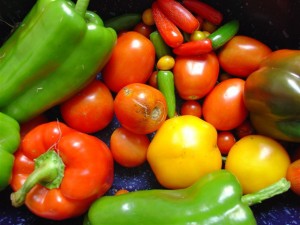Negative calorie foods are real and not mythical at all. The scientific explanation follows below the list of low calorie foods…
You can create your own negative calorie salads, negative calorie drinks and other food treat combinations. An example of a really great tasting recipe is this Chilled Vegetable drink: Low calorie Veggie Shake
 Here is a quick list of foods where the TEF (Thermic Effect of Food) is higher than 10% VOLUME
Here is a quick list of foods where the TEF (Thermic Effect of Food) is higher than 10% VOLUME
- Grapefruit — Total calories:46
Mushrooms — Total calories:15
Tomatoes — Total calories:44
Radishes — Total calories:19
Fennel — Total calories:27
Celery — Total calories:16
Berries — Total calories:64
Carrots — Total calories:44
Turnips — Total calories:36
Watercress — Total calories:4
Zucchini — Total calories:20
Spinach — Total calories:7
Asparagus — Total calories:27
Broccoli — Total calories:31
Brussel sprouts — Total calories:38
Cabbage — Total calories:22
Lettuce — Total calories:5
Beets — Total calories:74
Lemons and limes — Total calories:56
Kale — Total calories:5
Pep s — Total calories:60
Onions — Total calories:64
Pumpkin — Total calories:30
Garlic — Total calories:4 (per clove)
Scientifically: Are negative calorie foods really a myth or do they really exist?
The simple answer is that it depends on your definition of negative calorie foods.
If your definition includes consideration for the volume of the food and includes the body total daily energy requirement, then yes, negative calorie foods do exist!
If your definition simply asks whether the TEF delivery percentage exceeds 100, then no, negative calorie foods do not exist.
According to the Internationally acclaimed Mayo Clinic up to 10 percent of your total energy expenditure goes towards the storage and digestion of food. Should you fill up your stomach the whole day long, with only chopped kale (at 4 calories per 250ml volume) and other non starchy vegetables, it will be that you will burn much more total energy than you are consuming. So, when adding to the energy calculation, factually kale is a negative calorie food. The TEF (Thermic Effect of Food) of kale is extremely high (some say far greater than 50% TEF) other low calorie veggies, like celery is closer to 20% TEF and that of lettuce around 30%
Practically though it is a mute distinction as you will not be able to just eat lettuce for long and it is not healthy at all as your body needs many different types of nutrients.
Advertising

All information provided for information & education purposes only. Nothing published on https://dietmy.com is intended as substitution for medical advice, diagnosis, or for any treatment.



